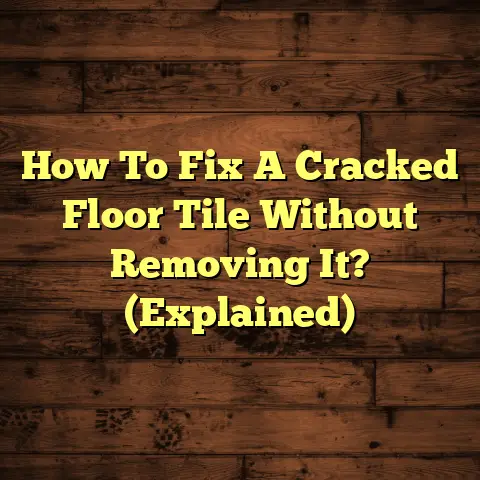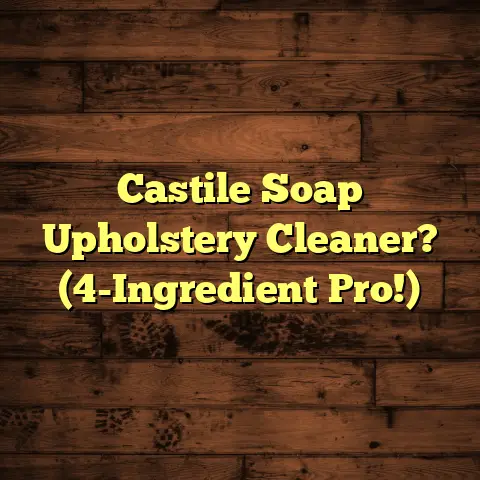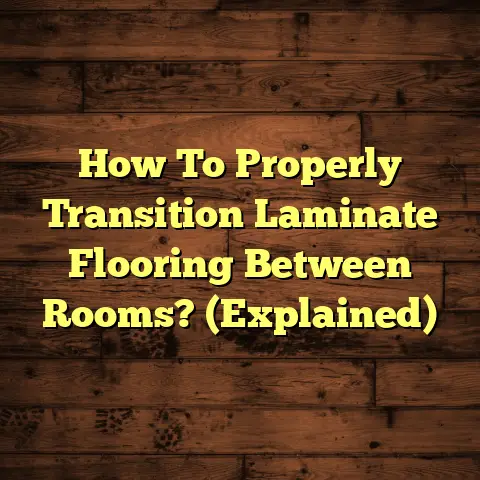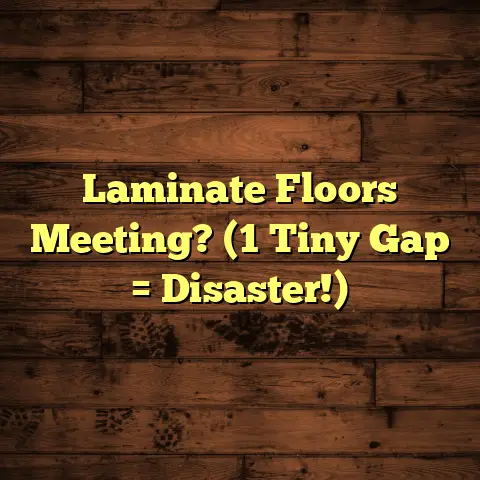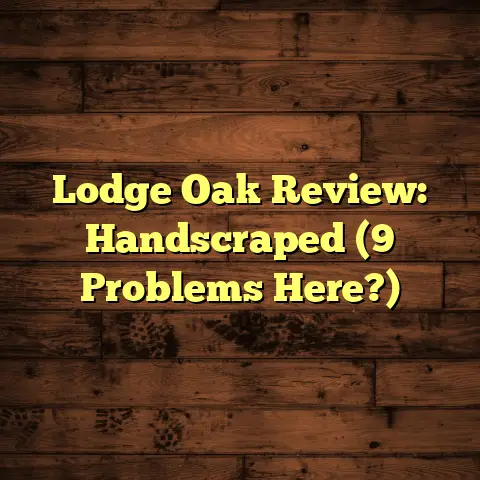Is It Safe To Use Pledge On Wood Floors?
A Contractor’s Honest Opinion
Do you remember that smell? That distinct, almost sweet, lemony scent that filled the house after a good cleaning?
For me, it’s the smell of my grandmother’s house. I can almost see her now, polishing her gleaming wood floors with Pledge, a ritual performed with the precision of a surgeon.
The floors always looked fantastic, reflecting the warm light of the afternoon sun. Family gatherings always seemed brighter, somehow, because of those floors.
But times change, and so does our understanding of what’s best for our homes. Maintaining wood floors is an art and a science.
And that got me thinking, is Pledge really the best choice for keeping those beautiful wood floors in top condition? Or are there better, safer alternatives out there?
Let’s dive in and find out, shall we?
The Allure of Wood Flooring
Wood floors, they just have a certain something, don’t they? They add warmth, character, and a touch of elegance to any home.
Whether it’s the classic charm of solid hardwood or the practical appeal of engineered wood, there’s no denying their popularity.
Think about it: hardwood floors can last for generations, becoming a family heirloom in their own right.
But that longevity hinges on proper care. Cleaning and maintenance are key to preserving their beauty and preventing damage.
And that’s where the questions start popping up: What products are safe to use? Which ones should we avoid?
Different Types of Wood Floors
Before we get into the nitty-gritty of Pledge, let’s quickly touch on the different types of wood floors you might have in your home.
-
Solid Hardwood: This is the real deal. Think oak, maple, cherry – planks cut from a single piece of wood. It’s durable, can be refinished multiple times, and adds significant value to your home.
-
Engineered Wood: This consists of a thin layer of hardwood bonded over a plywood core. It’s more stable than solid hardwood, especially in areas with high humidity, and often more affordable.
-
Laminate: While it mimics the look of wood, laminate is actually a synthetic material. It’s durable, scratch-resistant, and budget-friendly, but it can’t be refinished like hardwood or engineered wood.
Each type of flooring has its own unique characteristics and requires different care. What works for solid hardwood might not be the best choice for laminate, and vice versa.
Pledge: A Household Name
Pledge. The name alone evokes images of sparkling clean surfaces and that familiar, fresh scent. It’s been a staple in households for generations, promising to dust, polish, and protect a variety of surfaces.
But what exactly is Pledge? It’s essentially a blend of waxes, silicones, solvents, and propellants, designed to create a protective layer and enhance the shine of furniture and other surfaces.
Pledge Product Line-Up
Over the years, Pledge has expanded its product line to cater to different cleaning needs. You’ve probably seen these on the shelves:
-
Pledge Multi-Surface: This is the all- purpose workhorse, designed for use on wood, glass, metal, and more.
-
Pledge FloorCare: Specifically formulated for floors, this promises to clean and shine without leaving a sticky residue.
The key difference lies in the formulation. FloorCare products often contain different types of waxes and polymers to provide better durability and slip resistance on floors.
The Appeal of Pledge
So, why is Pledge so popular? Well, it’s easy to use, readily available, and smells great. A quick spray and wipe, and you’re done.
Plus, the marketing promises a beautiful shine and protection against dust and grime. Who wouldn’t want that?
But here’s the thing: just because something is popular and convenient doesn’t necessarily mean it’s the best choice for your wood floors.
The Big Question: Is Pledge Safe for
Wood Floors?
Okay, let’s get down to brass tacks. Is it really safe to use Pledge on your wood floors? The answer, as with most things in life, is a bit complicated.
It depends on several factors, including the type of wood floor you have, the type of Pledge product you’re using, and how often you’re using it.
Reading the Fine Print
The first thing I always tell my clients is: read the label! Pledge, like any cleaning product, comes with instructions and warnings.
Pay close attention to the surfaces it’s recommended for and any precautions you should take.
Some Pledge products specifically state that they’re safe for use on wood floors, while others might be more general-purpose.
Potential Risks
Even if a Pledge product claims to be safe for wood floors, there are still potential risks to consider:
-
Buildup: Over time, the waxes and silicones in Pledge can build up on the surface of your floors, creating a dull, hazy film. This buildup can attract dirt and make your floors look even dirtier.
-
Slipperiness: The waxy residue can also make your floors slippery, increasing the risk of falls, especially for children and the elderly.
-
Finish Damage: Some of the solvents in Pledge can potentially damage the finish on your wood floors, especially if they’re older or have a delicate coating.
-
Refinishing Issues: If you ever decide to refinish your wood floors, the Pledge buildup can interfere with the adhesion of the new finish, leading to problems down the road.
Expert Opinions
I’m not the only one who’s a bit wary of using Pledge on wood floors. Many flooring specialists and manufacturers advise against it.
According to the National Wood Flooring Association (NWFA), it’s generally best to use cleaning products specifically designed for wood floors and to follow the manufacturer’s instructions carefully.
Pledge vs. the Alternatives
So, if Pledge isn’t the ideal choice, what are the alternatives? Luckily, there are plenty of other options available, ranging from specialized wood floor cleaners to simple, natural solutions.
Wood Floor Cleaners
These are specifically formulated to clean and protect wood floors without leaving behind a sticky residue or damaging the finish.
Brands like Bona, Murphy Oil Soap (used sparingly and diluted properly), and Armstrong offer a variety of wood floor cleaners that are widely recommended by flooring professionals.
Natural Cleaning Solutions
For those who prefer a more natural approach, there are several DIY cleaning solutions you can try:
-
Vinegar and Water: A solution of equal parts white vinegar and water can be effective for removing dirt and grime. Just be sure to use it sparingly, as excessive moisture can damage wood floors.
-
Soap-Based Cleaners: A mild soap, such as castile soap, diluted in water can also be used to clean wood floors. Again, use it sparingly and be sure to rinse thoroughly to remove any residue.
Comparing the Options
| Feature | Pledge | Wood Floor Cleaner | Natural Solutions |
|---|---|---|---|
| Effectiveness | Good for dusting | Excellent cleaning | Moderate cleaning |
| Safety | Potential risks | Generally safe | Generally safe |
| Residue | Can leave buildup | Minimal residue | Minimal residue |
| Cost | Affordable | Moderate | Very affordable |
| Convenience | Very convenient | Convenient | Less convenient |
Consumer Reviews
I always encourage my clients to do their own research and read reviews from other homeowners before choosing a cleaning product.
You’ll find a wide range of opinions on Pledge, with some people swearing by it and others reporting problems with buildup or slipperiness.
The same goes for alternative products. Some people find vinegar and water to be just as effective as commercial cleaners, while others prefer the convenience and performance of specialized wood floor cleaners.
Real-World Experiences
Let’s get real for a moment. I’ve talked to countless homeowners over the years about their experiences with Pledge and other floor cleaning products.
I’ve heard stories of floors becoming dull and sticky after years of Pledge use, requiring professional cleaning or even refinishing to restore their original beauty.
On the other hand, I’ve also heard from people who’ve used Pledge on their wood floors for years without any problems, attributing their success to careful application and regular cleaning.
Frequency and Routine
One thing I’ve noticed is that the frequency of cleaning and the overall cleaning routine can make a big difference.
People who clean their floors more often and use Pledge sparingly are less likely to experience buildup or other problems.
Those who rarely clean their floors or use Pledge liberally are more likely to encounter issues.
The Verdict: Proceed with Caution
So, after all this, what’s my final verdict on Pledge? I’d say proceed with caution.
While it’s not necessarily a completely bad product, there are definitely better and safer options available for cleaning your wood floors.
If you do choose to use Pledge, I recommend using it sparingly, following the instructions carefully, and monitoring your floors for any signs of buildup or damage.
And most importantly, consider exploring alternative cleaning products that are specifically designed for wood floors and won’t pose the same risks.
Making Informed Decisions
Ultimately, the best way to care for your wood floors is to educate yourself, read reviews, and make informed decisions based on your specific needs and preferences.
Don’t just rely on marketing claims or nostalgic memories. Take the time to research and choose products that will protect your floors and keep them looking their best for years to come.
Convenience vs. Care
In the end, it’s a balancing act between convenience and care. Pledge might be quick and easy to use, but it could potentially cause problems down the road.
By choosing safer and more effective cleaning products, you can ensure that your wood floors remain beautiful and durable for generations to come.
And who knows, maybe one day your grandchildren will be reminiscing about the scent of your favorite floor cleaner, creating their own cherished memories in a home filled with warmth and beauty.
